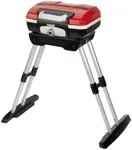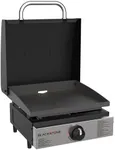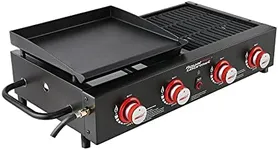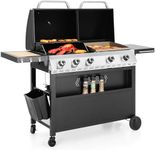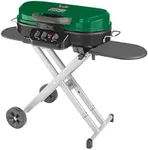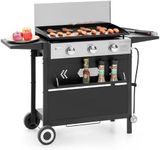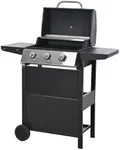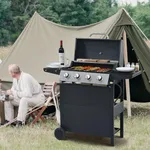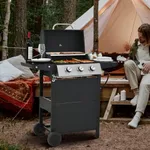Buying Guide for the Best Tabletop Propane Grills
Choosing the right tabletop propane grill can significantly enhance your outdoor cooking experience. Whether you're planning a camping trip, a picnic, or just a small backyard barbecue, a tabletop propane grill offers convenience and portability. To make the best choice, it's important to understand the key specifications and how they align with your needs. Here are the essential specs to consider when selecting a tabletop propane grill.Size and Cooking AreaThe size and cooking area of a tabletop propane grill determine how much food you can cook at once. This is important because it affects how many people you can serve in one go. Smaller grills with a cooking area of around 100-200 square inches are suitable for 1-2 people, making them ideal for solo trips or couples. Medium-sized grills with 200-300 square inches can handle small family meals. Larger grills with over 300 square inches are better for groups or parties. Choose a size based on how many people you typically cook for.
BTU RatingBTU (British Thermal Units) rating measures the heat output of the grill. A higher BTU rating means the grill can produce more heat, which is important for cooking food quickly and evenly. For small grills, a BTU rating of 5,000-10,000 is usually sufficient. Medium grills may require 10,000-15,000 BTUs, while larger grills might need 15,000-20,000 BTUs. Consider your cooking style and the types of food you plan to grill; if you need high heat for searing steaks, a higher BTU rating is beneficial.
PortabilityPortability is a key feature for tabletop propane grills, especially if you plan to take it on the go. This includes the weight of the grill, the presence of carrying handles, and how compact it is when stored. Lightweight grills (under 20 pounds) are easier to carry and transport, making them ideal for camping and picnics. Heavier grills may offer more stability and features but can be cumbersome to move. Choose a grill that balances portability with your need for stability and additional features.
Build Quality and MaterialsThe build quality and materials of the grill affect its durability and performance. Stainless steel and cast iron are common materials that offer good heat retention and resistance to rust. Stainless steel is lightweight and easy to clean, while cast iron provides excellent heat distribution but is heavier. Consider where and how often you will use the grill; if you need something durable for frequent use, opt for high-quality materials. For occasional use, lighter materials may suffice.
Ignition SystemThe ignition system is what starts the grill. Common types include push-button ignition, electronic ignition, and match light ignition. Push-button and electronic ignitions are more convenient and safer, as they allow you to start the grill with a simple press or turn. Match light ignition requires manually lighting the grill with a match or lighter, which can be less convenient. Choose an ignition system based on your preference for ease of use and reliability.
Temperature ControlTemperature control is crucial for cooking different types of food properly. Look for grills with adjustable heat settings or multiple burners, which allow you to control the temperature more precisely. Single burner grills are simpler and suitable for basic grilling, while multiple burners offer more flexibility for cooking various foods at different temperatures. Consider what types of food you plan to cook and how much control you need over the cooking process.
Ease of CleaningEase of cleaning is an important factor to consider, as it affects how much maintenance the grill requires. Features like removable grates, drip trays, and non-stick surfaces can make cleaning easier. Stainless steel grates are easier to clean than cast iron but may not retain heat as well. Consider how much time you are willing to spend on cleaning and choose a grill with features that simplify the process.

